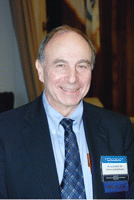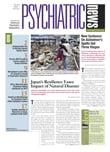No, Murray Raskind, M.D., has not discovered a cure for posttraumatic stress disorder (PTSD). But he has found a way to decrease the incidence and severity of one key PTSD symptom—nightmares—for combat veterans.
That may seem like a modest achievement, but for a veteran who hasn't slept well in years, it can be a major step closer to a normal life, said Raskind, speaking at the annual Amygdala Conference, held at the Uniformed Services University of the Health Sciences in Bethesda, Md., in April.
Raskind is director of the Department of Veterans Affairs Northwest Network VISN 20 Mental Illness Research, Education, and Clinical Center at the Veterans Affairs Puget Sound Health Care System in Tacoma, Wash., a professor and vice chair of the Department of Psychiatry and Behavioral Sciences at the University of Washington, and a staff psychiatrist at Madigan Army Medical Center.
The intervention he offers and has been testing for a decade and a half in clinical trials is, in his words, an "ancient therapeutic"—the alpha-1 adrenergic receptor antagonist prazosin, which was developed almost 40 years ago as an antihypertensive drug.
He began his research career studying Alzheimer's disease. When he was recruited to the Seattle VA in 1995, he was asked to take over a stress-disorders program for African-American veterans after the previous leader left.
"I went from working with people who couldn't remember to people who couldn't forget," he said.
To help these veterans, Raskind used a combination of observational, basic scientific, and clinical reasoning that led him to prazosin.
"My clinical work with PTSD with Vietnam combat vets suggested that trauma nightmares with distressed awakenings resembled adrenergic ‘storms,’" the adrenaline surge that saves lives in combat, he said in an interview.
That surge, if sustained, leads to a long-lasting up-regulation of adrenoreceptor response to norepinephrine in the brain, contributing to reexperiencing and hyper-arousal and leading to nightmares and sleep disruptions.
Existing basic research suggested that the mechanism for adrenergic hyperactivity in combat-related PTSD was predominantly postsynaptic.
Raskind reasoned that a postsynaptic adrenergic receptor (AR) antagonist drug that crossed the blood/brain barrier might reduce PTSD trauma nightmares and normalize sleep.
Propranolol (a beta antagonist) and prazosin (an alpha antagonist) are considered to be the best drugs in their classes for crossing the blood/brain barrier.
Propranolol Tried First
"I first prescribed a veteran propranolol, given its usefulness for some anxiety states, but was then unaware that beta AR antagonists can intensify dreams," he said. "Sure enough, his nightmares worsened on propranolol."
He knew from his research on adrenergic regulation of neuropeptide release in human aging that alpha-1 AR antagonists often had opposite effects from those of beta AR antagonists. That led him to prescribe prazosin.
Once an adequate dose was reached, the veteran's nightmares and distressed awakenings disappeared.
Nightmares arise from disrupted REM sleep. The prazosin restores normal REM sleep and permits "decoupling" of emotional tone from memory, he said.
More evidence for the value of prazosin came from another direction.
"My confidence in prazosin was bolstered when I asked another vet with PTSD whether the prazosin prescribed by his urologist for benign prostatic hypertrophy had improved his nightmares, and he said it had," Raskind said.
He then began a series of clinical trials, first open label and then double blind, placebo controlled, with "excellent results."
An initial trial with 10 veterans found that patients taking prazosin increased sleep from three to four hours a night at baseline by an additional 94 minutes, on average.
"And here we are with an effective and inexpensive treatment for previously often intractable PTSD symptoms," he said.
Starting With Low Dose Is Key
Today, Raskind starts each patient on very low doses, 1 mg at bedtime, titrating up to as much as 20 mg. Patients have to habituate to the drug because it is a vasodilator, the basis of its use for hypertension.
"It can cause orthostatic dizziness, especially in young women and users of beta blockers or ED drugs," he said. Lower blood pressure is a common side effect, too.
He noticed another thing. Many of his patients had been using alcohol as a way to get to sleep. As he treated more patients with prazosin, Raskind learned that some had stopped drinking.
Since then, Raskind has collaborated with his colleague at the VA, psychologist Tracy Simpson, Ph.D., on studies of prazosin and drinking. In a paper published two years ago, studying 17 male subjects without PTSD, they said that the prazosin group reported fewer drinking days per week (5.7 days vs. 0.9 days) and fewer drinks per week (20.8 drinks vs. 2.6) compared with placebo during the final three weeks of the study.
Simpson is now conducting a placebo-controlled trial of prazosin in people with co-occurring alcohol dependence and PTSD.
Raskind has also begun new larger trials, including one of 120 veterans of the fighting in Iraq and Afghanistan, and another three-year, multisite trial of 300 veterans.
Prazosin has several practical advantages. It is cheap: five cents a day per patient. It is also nonsedating, nonaddictive, and lipid soluble, and, he said, "They didn't design it to stay out of the brain."
Best of all, since prazosin is long off patent, "no pharma reps will call." That may also explain why use of prazosin to treat nightmares in PTSD has expanded slowly, Raskind believes.
The true key to clinical usage appears to be "distance from Murray," he said, an observation borne out by a study in the April 2009 Archives of General Psychiatry by Ilan Harpaz-Rotem, Ph.D., and Robert Rosenheck, M.D., of the Department of Psychiatry at Yale.
"Whereas 37.6 percent of patients with PTSD treated within the Veterans Affairs Puget Sound Health Care System, Tacoma, Washington, in 2004 were prescribed prazosin, only 18.2 percent were treated with prazosin at medical centers up to 499 miles away, 6.7 percent at centers 500 to 999 miles away, 4.0 percent at centers 1,000 to 2,499 miles away, and 1.9 percent at centers 2,500 miles away or farther," they wrote.

